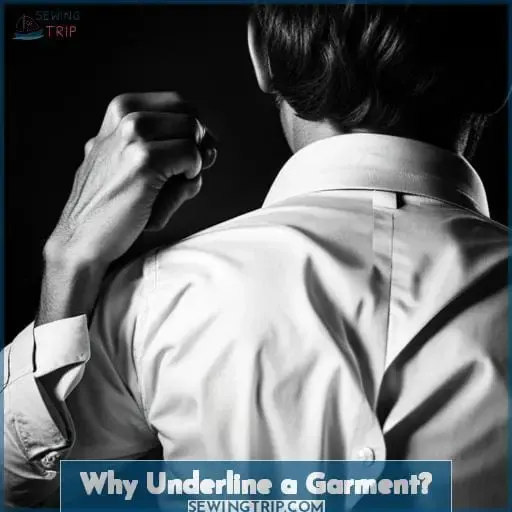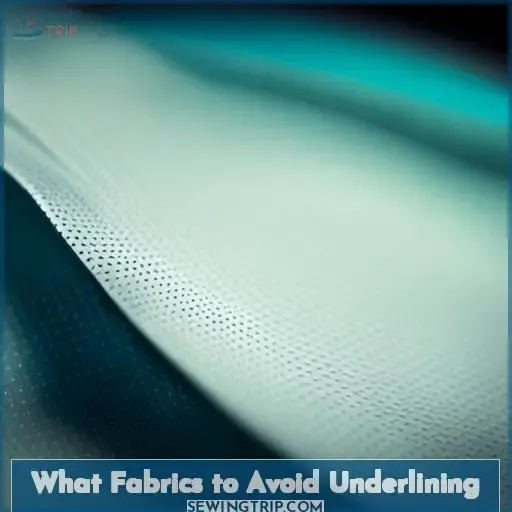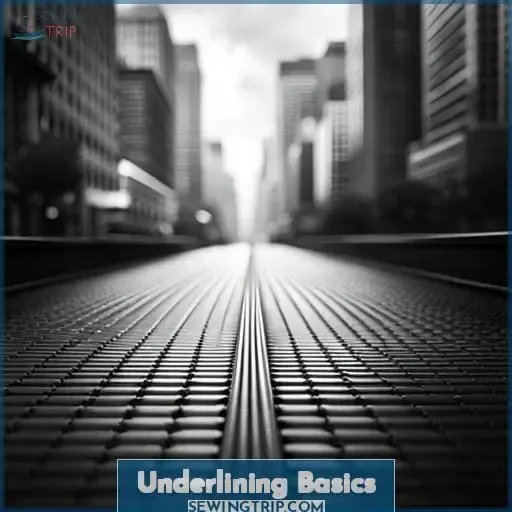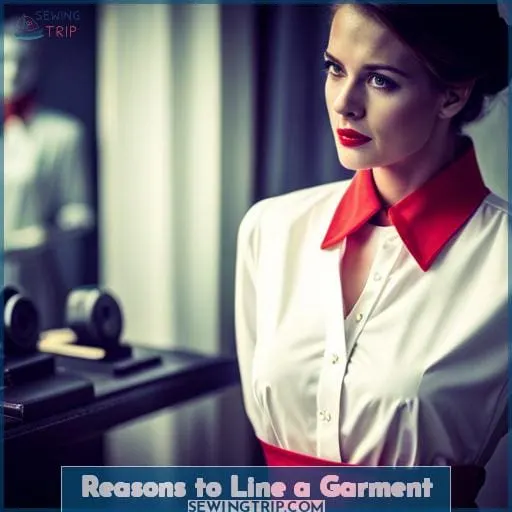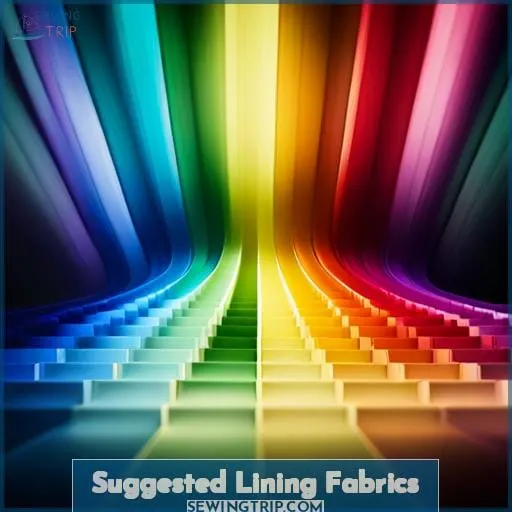This site is supported by our readers. We may earn a commission, at no cost to you, if you purchase through links.
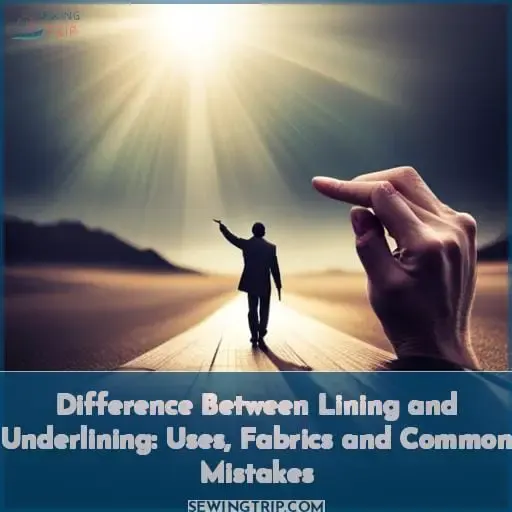 The difference between lining and underlining is complex as all get out, y’all.
The difference between lining and underlining is complex as all get out, y’all.
Lining is that silky stuff on the inside that lets your jacket slide on smooth. Makes things comfy too.
Underlining, that’s adding a layer underneath for structure and heft. Tricky stuff, don’tcha know.
But once you get the hang of it, you’ll be styling and profiling in handmade duds in no time flat.
So read up and get creative, sewing wizard!
Table Of Contents
- Key Takeaways
- What is Underlining?
- Why Underline a Garment?
- What Fabrics to Avoid Underlining
- Underlining Basics
- Common Underlining Mistakes
- What is Lining?
- Reasons to Line a Garment
- Suggested Lining Fabrics
- Difference Between Lining and Underlining
- When to Use Each Technique
- Frequently Asked Questions (FAQs)
- Conclusion
Key Takeaways
- Lining conceals unfinished seams and provides added comfort against the skin.
- Underlining adds body and structure to lightweight fabrics and can prevent stretching in knits.
- Lining is ideal for sheer fabrics as it provides opacity and prevents underwear from showing through.
- Underlining can be used to change the color of the main fabric and prevent shrinking in garments.
What is Underlining?
Underlining is a layer of fabric placed underneath the main fabric of a garment. It serves multiple purposes and can be used to change the properties of the fabric, such as making it more opaque or stiffer.
One reason you might want to underline a garment is to make it more opaque, especially if you’re using a sheer or lightweight fabric. This helps prevent your underwear from showing through your clothes, providing that extra sense of liberation and confidence in your outfit choice.
Another benefit of underlining is that it can add structure to a garment. By adding an underlining layer, you can make the garment stiffer and ensure that it holds its shape well throughout wear, giving you power over how your clothing looks on your body.
Additionally, underlining can help improve the fit by preventing stretching out in stretchy fabrics like knits.
Why Underline a Garment?
When it comes to underlining a garment, there are two main reasons why you might want to consider doing so.
Firstly, underlining can add opacity to sheer or lightweight fabrics, preventing your underwear from showing through.
Secondly, underlining can add structure and stiffness to a garment that needs to hold its shape.
By understanding these benefits of underlining, you can make informed decisions about when and how to incorporate this technique into your sewing projects.
Add Opacity
To achieve a more opaque look for your garment, consider adding underlining.
Underlining can help to make lightweight fabrics appear less sheer and more opaque.
By placing a layer of underlining beneath the main fabric, you can prevent transparency and ensure that your underwear doesn’t show through.
This technique is especially useful when working with sheer or transparent fabrics that lack opacity on their own.
Underlining also works well with heavy fabrics by providing additional structure without sacrificing breathability or comfort.
- Lightweight fabric: More opacity
- Sheer fabric: Less opaque
- Transparent fabric: More opaque
Add Structure
Add structure to your garment by underlining it with a layer of fabric.
Underlining helps with draping, prevents stretching and sagging, and adds warmth to the garment.
By providing an additional layer of support, underlining ensures that your clothing maintains its shape and structure throughout wear. It’s especially beneficial when working with lightweight fabrics or those prone to sheerness.
When you underline a garment, you’re essentially reinforcing it from within, creating a sturdy foundation for the outer fabric. This technique can be particularly useful for skirts, dresses, or any other garments that require stability and durability in their construction.
What Fabrics to Avoid Underlining
Avoid using heavy or bulky fabrics when underlining a garment. These types of fabrics can make the garment look awkward and add unnecessary bulk. Instead, opt for lightweight fabrics that will provide structure without weighing down the overall design.
Here are three types of fabrics to avoid underlining:
- Heavy Fabrics: Thick materials such as wool or denim shouldn’t be used as underlining fabric.
- Stretch Fabrics: While stretchy materials may seem like a good choice for added comfort, they don’t work well as underlining fabric. Their elasticity can lead to shrinkage and distortion over time, compromising the fit of your garment.
- Knit Fabrics: Similar to stretch fabrics, knit materials have inherent give and stretchiness that are unsuitable for an underlayer.
When selecting an appropriate fabric for underlining, consider lightweight options such as cotton broadcloth or muslin if you’re working with lighter garments like dresses or blouses; whereas organza or tulle is more suitable when dealing with heavier weight applications where additional stiffness is desired.
Remember that proper selection of these items contributes greatly on achieving intended outcomes during construction process.
Underlining Basics
Now that you know which fabrics to avoid underlining, let’s dive into the basics of underlining.
Underlining is a technique that involves adding a layer of fabric underneath the main fabric of a garment.
- It prevents stretching
- Adds body and structure
- Improves the overall fit
When underlining a garment, it’s crucial to cut the underlining to match each pattern piece exactly. This ensures that both layers align perfectly during construction. By sewing the underlining to the wrong side of your main fabric within the seam allowance, you can keep it securely in place without any visible stitching on the outside.
One key aspect when working with an underline is choosing an appropriate lightweight fabric.
Common Underlining Mistakes
When underlining a garment, there are common mistakes that you should avoid.
One mistake is using a bulky fabric for the underlining, which can make the garment look awkward and bulky.
Another mistake is cutting the underlining to be the same length as the main fabric, causing it to show through.
Lastly, stitching with a wide seam allowance can allow the underlining to shift around and bunch up.
Bulky Fabric
One common mistake to avoid when underlining a garment is using a heavy or bulky fabric, as it can make the finished product look awkward and cumbersome.
Bulky fabric makes the garment stiff and difficult to sew, leading to puckering and shifting of the layers. It also adds unnecessary bulk at areas such as facing, seam allowances, darts, neck facings, and pocket bags.
To ensure a smooth finish with underlining, opt for lightweight fabrics that provide structure without adding excessive weight or thickness.
Inaccurate Cutting
When adding an underlining layer to your garment, accuracy in cutting is crucial for achieving a professional finish.
Make sure you don’t cut the underlining piece of fabric exactly at par with that of your main material; doing so might allow it to peek through uncomfortably afterwards!
The consequences of such inaccurate cuts aren’t just limited visibility – they extend into bulkiness (especially if using thick fabrics), uneven hems from shifted pieces during sewing operations like attaching facings or collars onto bodices which require precision alignment along seam lines without any excesses hanging over edges creating unwanted bumps beneath finished surfaces; lastly there’s potential wrinkling leading poor fitting outcomes where seams begin pulling apart because they’ve been stretched outwards by neighboring ones trying compensate undue tension applied across panels comprising said workpiece forming less than desirable overall silhouette shape on wearers body proportions even though measurements seemed correct initially before assembly commenced but went wrong somewhere along process line causing distortion factors come play making proper adjustment necessary ensure comfortable clothing experience no matter what clothes being made whether skirts, dresses, shirts, pants, jackets, coats – three more complex items incorporating additional components beyond simple basic single-layered flat sections connected together form structural integrity whole ensemble.
Excessive Stitches
To avoid excess bulk and shifting, make sure to stitch the underlining to the main fabric within the seam allowance.
Excessive stitches can lead to bulkiness, puckering, and a wavy hem.
When you stitch too close or use too many stitches, it creates bulky seams that aren’t only unattractive but also affect how the garment hangs on your body.
Keep your stitching precise and minimal for a clean and polished finish.
What is Lining?
Now let’s delve into the world of lining and understand its purpose in a garment.
Lining is a crucial component that serves multiple functions, making it an essential element to consider when creating your own clothing masterpiece. It not only conceals unfinished seams, markings, or construction details but also provides added comfort against your skin.
Different types of lining fabrics can be used depending on the desired effect and fabric composition of the outer layer.
For knitted garments such as sweaters or dresses, a lightweight knit lining is often utilized to maintain the stretchiness and drape of the fabric while adding extra comfort for wearers. On the other hand, winter coats require thicker linings like flannel or fleece to provide insulation during colder months.
When it comes to dresses made from delicate fabrics like silk or chiffon, using a suitable lining helps prevent transparency issues while maintaining their flowy nature. Additionally, contrasting color linings can be employed as an interesting design feature for certain garments.
It’s important not to confuse lining with interfacing; although both serve different purposes within garments’ construction process – interfacing reinforces functional parts such as collars and cuffs whereas linings are placed throughout entire interior spaces providing overall coverage.
Reasons to Line a Garment
There are several reasons why you might choose to line a garment.
One of the main benefits is that lining helps to hide any seams or construction details on the inside, giving your garment a polished and professional finish.
Additionally, lining can add an extra layer of comfort against your skin, making it more enjoyable to wear throughout the day.
Hide Seams
To achieve a polished and seamless look, lining is used in garments to hide seams and construction details. Lining serves multiple purposes that can greatly enhance the overall quality of a garment.
- Prevent sheerness: Lining adds an extra layer of fabric to prevent sheer or transparent fabrics from revealing too much.
- Improve fit: By adding body and structure, lining helps improve the fit of a garment by preventing it from stretching out.
- Add warmth: Interlining with materials like fleece or flannel can provide additional warmth during colder seasons.
- Add body: Underlining lightweight fabrics with cotton broadcloth or muslin adds body, giving more structure and shape to the garment.
- Prevent stretching: The process of underlining reinforces delicate fabrics, preventing them from losing their shape over time.
Incorporating these techniques won’t only elevate your sewing skills but also ensure that your finished garments have both style and functionality.
Add Comfort
When lining a garment, one of the reasons to consider is adding comfort to your overall wearing experience.
Lining prevents stretching and adds warmth, making your garment more comfortable in different weather conditions.
It also prevents sheer fabrics from being see-through, ensuring that you feel confident and secure when wearing them.
Additionally, lining can be used to add design details such as contrasting colors or patterns for an interesting visual effect.
Lastly, it helps garments drape better by providing structure and support.
So next time you’re considering whether or not to line a garment, remember the added comfort it can bring to your wardrobe choices.
Suggested Lining Fabrics
For lining fabrics, consider using lightweight materials such as silk, polyester, rayon, or acetate to provide a layer of comfort and conceal unfinished seams or construction details.
Choosing the right fabric for lining is essential to ensure the desired effect and functionality of your garment.
- Cotton broadcloth: This versatile fabric is breathable and easy to work with. It provides a smooth finish without adding bulkiness.
- Cotton batiste: Known for its softness and delicate drape, cotton batiste adds an elegant touch to any garment while still offering comfort.
- Muslin: Muslin is often used as a mock-up fabric during fitting sessions but can also serve as an excellent choice for linings due to its affordability and durability.
- Organza: If you want added structure or volume in your garments while maintaining transparency when needed, organza makes an ideal choice.
- Tulle: Tulle adds subtle texture underneath sheer fabrics without compromising their lightness. It’s perfect for evening wear or special occasion dresses where you want that extra bit of elegance.
When selecting a lining fabric remember that it should complement the outer material in terms of weight, color, and texture. Choose high-quality materials that will enhance the overall look and feel of your garment.
Spend time experimenting with different options until you find the perfect match for your design.
Difference Between Lining and Underlining
When determining the difference between lining and underlining, it’s important to understand their distinct uses and purposes within a garment.
Lining is a layer of fabric that conceals unfinished seams, markings, or construction details while providing comfort.
On the other hand, underlining adds body and structure to lightweight fabrics and can also provide opacity for sheer or transparent fabrics.
Here’s a table summarizing the main differences between lining and underlining:
| Lining | Underlining | |
|---|---|---|
| Uses | Concealment of seams | Adding body/structure; Providing opacity |
| Fabrics | Silky/lightweight (silk,polyester) | Cotton broadcloth/muslin; Organza/tulle |
Lining primarily focuses on hiding internal elements of the garment while adding an extra layer of comfort against your skin. It often consists of silk, polyester rayon acetate due to their smooth texture. In contrast, underlining serves different functions like providing support for draping garments or stretchy materials where stability is needed.
Underlying with cotton broadcloth muslin enhances warmth in colder climates whereas using organza tulle helps maintain shape in heavier-weight fabric applications such as gowns or ballroom dresses.
Understanding these distinctions will allow you to choose whether you need lining for concealment purposes or if you require additional support provided by an underlying layer.
When to Use Each Technique
To determine whether to use lining or underlining, consider the specific needs of your garment and how each technique can fulfill those needs.
- Lining is often used for sheer fabrics, as it provides opacity and prevents underwear from showing through.
- It’s also ideal for lightweight fabrics, offering a layer of comfort against the skin.
- On the other hand, underlining is great for adding structure to lightweight fabrics and can be used to make them more opaque if necessary.
- Underlining works well with stretch fabrics too since it helps prevent stretching out and maintains a better fit over time.
When making quilted jackets or winter coats, interlining becomes essential as it adds an extra layer of warmth between the outer fabric and lining.
In summary:
- Use lining when you need opacity in sheer garments or added comfort in lightweight ones.
- Choose underlining when you want to add structure to lightweight materials like cotton broadcloth or muslin.
- Employ interlining for quilted jackets or winter coats that require additional insulation.
By understanding when each technique should be applied based on your specific garment requirements, you can ensure optimal results in terms of both functionality and aesthetics.
Frequently Asked Questions (FAQs)
Can underlining be used to change the color of the main fabric?
Yes, underlining can be used to change the color of the main fabric. By adding an underlining layer in a different color, you can alter the appearance of your garment and create interesting design effects.
Is underlining always necessary for lightweight fabrics?
Underlining isn’t always necessary for lightweight fabrics. It can be used to add structure and opacity, but it may also make the garment look bulky. Consider the desired outcome and fabric properties before deciding to underline.
Can underlining help to prevent a garment from shrinking?
Underlining can prevent a garment from shrinking by adding stability and preventing stretching. It symbolizes the power to control your clothing’s fate, liberating you from ill-fitting garments.
Are there any specific techniques for joining the underlining with the main fabric?
To join the underlining with the main fabric, stitch within the seam allowance. This will keep it in place and prevent shifting.
Be sure to cut the underlining slightly shorter than the main fabric to avoid visibility.
Can underlining be added to a finished garment, or does it need to be done during the construction process?
Underlining can be added to a finished garment, but it’s best done during the construction process. This technique adds depth and strength, like unlocking hidden potential within yourself.
Conclusion
To sum it up, understanding the difference between lining and underlining is key to creating well-crafted garments.
Underlining adds structure and opacity, while lining hides seams and adds comfort.
When it comes to fabric choices, be mindful of what works best for each technique.
By knowing when to use each technique, you’ll be able to confidently create handmade duds that are both stylish and comfortable.


